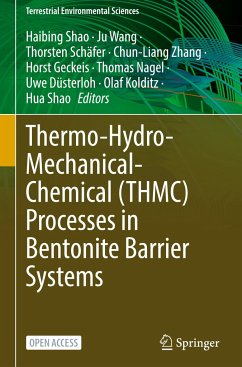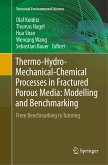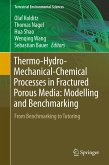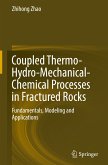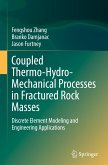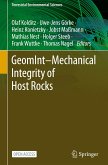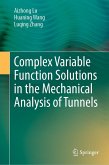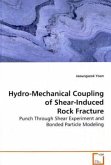Thermo-Hydro-Mechanical-Chemical (THMC) Processes in Bentonite Barrier Systems
Herausgegeben:Shao, Haibing; Wang, Ju; Schäfer, Thorsten; Zhang, Chun-Liang; Geckeis, Horst; Nagel, Thomas; Düsterloh, Uwe; Kolditz, Olaf; Shao, Hua
Thermo-Hydro-Mechanical-Chemical (THMC) Processes in Bentonite Barrier Systems
Herausgegeben:Shao, Haibing; Wang, Ju; Schäfer, Thorsten; Zhang, Chun-Liang; Geckeis, Horst; Nagel, Thomas; Düsterloh, Uwe; Kolditz, Olaf; Shao, Hua
- Gebundenes Buch
- Merkliste
- Auf die Merkliste
- Bewerten Bewerten
- Teilen
- Produkt teilen
- Produkterinnerung
- Produkterinnerung
This book is open access book. The collaborative Pilot Project, titled "Comparison of Thermo-Hydro-Mechanical-Chemical (THMC) Processes in Bentonite Barrier Systems", aims to investigate the fundamentals, conduct laboratory and field experiments, and develop numerical models for barrier systems that ensure the safe isolation of radioactive waste in deep geological repositories. This book compares methodologies and technologies used in experimental laboratory and field research, as well as systems analysis, in a collaborative work of German and Chinese scientists. Both parties have access to…mehr
Andere Kunden interessierten sich auch für
![Thermo-Hydro-Mechanical-Chemical Processes in Fractured Porous Media: Modelling and Benchmarking Thermo-Hydro-Mechanical-Chemical Processes in Fractured Porous Media: Modelling and Benchmarking]() Thermo-Hydro-Mechanical-Chemical Processes in Fractured Porous Media: Modelling and Benchmarking77,99 €
Thermo-Hydro-Mechanical-Chemical Processes in Fractured Porous Media: Modelling and Benchmarking77,99 €![Thermo-Hydro-Mechanical-Chemical Processes in Fractured Porous Media: Modelling and Benchmarking Thermo-Hydro-Mechanical-Chemical Processes in Fractured Porous Media: Modelling and Benchmarking]() Thermo-Hydro-Mechanical-Chemical Processes in Fractured Porous Media: Modelling and Benchmarking77,99 €
Thermo-Hydro-Mechanical-Chemical Processes in Fractured Porous Media: Modelling and Benchmarking77,99 €![Coupled Thermo-Hydro-Mechanical-Chemical Processes in Fractured Rocks Coupled Thermo-Hydro-Mechanical-Chemical Processes in Fractured Rocks]() Zhihong ZhaoCoupled Thermo-Hydro-Mechanical-Chemical Processes in Fractured Rocks108,99 €
Zhihong ZhaoCoupled Thermo-Hydro-Mechanical-Chemical Processes in Fractured Rocks108,99 €![Coupled Thermo-Hydro-Mechanical Processes in Fractured Rock Masses Coupled Thermo-Hydro-Mechanical Processes in Fractured Rock Masses]() Fengshou ZhangCoupled Thermo-Hydro-Mechanical Processes in Fractured Rock Masses123,99 €
Fengshou ZhangCoupled Thermo-Hydro-Mechanical Processes in Fractured Rock Masses123,99 €![GeomInt-Mechanical Integrity of Host Rocks GeomInt-Mechanical Integrity of Host Rocks]() GeomInt-Mechanical Integrity of Host Rocks41,99 €
GeomInt-Mechanical Integrity of Host Rocks41,99 €![Complex Variable Function Solutions in the Mechanical Analysis of Tunnels Complex Variable Function Solutions in the Mechanical Analysis of Tunnels]() Aizhong LuComplex Variable Function Solutions in the Mechanical Analysis of Tunnels198,99 €
Aizhong LuComplex Variable Function Solutions in the Mechanical Analysis of Tunnels198,99 €![Hydro-Mechanical Coupling of Shear-Induced Rock Fracture Hydro-Mechanical Coupling of Shear-Induced Rock Fracture]() Jeoungseok YoonHydro-Mechanical Coupling of Shear-Induced Rock Fracture53,99 €
Jeoungseok YoonHydro-Mechanical Coupling of Shear-Induced Rock Fracture53,99 €-
-
-
This book is open access book. The collaborative Pilot Project, titled "Comparison of Thermo-Hydro-Mechanical-Chemical (THMC) Processes in Bentonite Barrier Systems", aims to investigate the fundamentals, conduct laboratory and field experiments, and develop numerical models for barrier systems that ensure the safe isolation of radioactive waste in deep geological repositories. This book compares methodologies and technologies used in experimental laboratory and field research, as well as systems analysis, in a collaborative work of German and Chinese scientists. Both parties have access to exceptional experimental and modelling research capabilities. The Beishan underground research laboratory (URL) is currently under construction in Gansu, China. It will serve as an international collaboration platform for URL research in the future. International cooperation is essential for excellent research and development due to the high cost of scientific programmes and technical operation of URLs, making it a precondition for providing secure solutions. This is important not only for deep geological repositories for radioactive waste disposal but also for other geoenergy applications, such as energy storage and geothermal energy utilization.
Hinweis: Dieser Artikel kann nur an eine deutsche Lieferadresse ausgeliefert werden.
Hinweis: Dieser Artikel kann nur an eine deutsche Lieferadresse ausgeliefert werden.
Produktdetails
- Produktdetails
- Terrestrial Environmental Sciences
- Verlag: Helmholtz-Zentrum für Umweltforschung / Springer / Springer Nature Switzerland / Springer, Berlin
- Artikelnr. des Verlages: 978-3-031-53203-0
- 2024
- Seitenzahl: 172
- Erscheinungstermin: 23. April 2024
- Englisch
- Abmessung: 241mm x 160mm x 15mm
- Gewicht: 461g
- ISBN-13: 9783031532030
- ISBN-10: 3031532031
- Artikelnr.: 69699736
- Herstellerkennzeichnung Die Herstellerinformationen sind derzeit nicht verfügbar.
- Terrestrial Environmental Sciences
- Verlag: Helmholtz-Zentrum für Umweltforschung / Springer / Springer Nature Switzerland / Springer, Berlin
- Artikelnr. des Verlages: 978-3-031-53203-0
- 2024
- Seitenzahl: 172
- Erscheinungstermin: 23. April 2024
- Englisch
- Abmessung: 241mm x 160mm x 15mm
- Gewicht: 461g
- ISBN-13: 9783031532030
- ISBN-10: 3031532031
- Artikelnr.: 69699736
- Herstellerkennzeichnung Die Herstellerinformationen sind derzeit nicht verfügbar.
Haibing Shao works as the staff scientist at the Helmholtz Centre for Environmental Research (UFZ). From 2014 to 2020, he has been working as a Junior Professor at the Freiberg University of Mining and Technology (TUBAF). As one of the main developers of the OpenGeoSys, his expertise is the modelling of reactive transport processes in the subsurface. Since 2018, he has been leading the research group Geothermal and Reactive Transport Processes with the UFZ. His research topics are focusing on the coupled geothermal and geochemical processes in both shallow and deep reservoirs. Currently, he is also serving as the Editor-in-Chief for the journal Geothermal Energy. Ju Wang obtained his BS degree from the Nanjing University in 1984, majored in Uranium Geology and Geochemistry. He started his career in Beijing Research Institute of Uranium Geology (BRIUG) in 1987 and then held a PhD in geology from BRIUG in 1991. He served BRIUG as Chief Engineer during 2004-2008 and Vice-President during 2008-2023. He is now the Chief Scientist of China National Nuclear Corporation in the field of radioactive waste disposal, the Director of China Atomic Energy Authority's Innovation Centre on Geological Disposal of High Level Radioactive Waste, and the Chief Designer of Beishan Underground Research Laboratory (URL) for Geological Disposal of High Level Radioactive Waste. He has been leading China's program on geological disposal of high level radioactive waste since 1999, including strategy development, site selection and site characterization, buffer material study, safety assessment of disposal system, design and construction of underground research laboratory. His achievements have resulted in the confirmation of Xinchang as the URL site and construction of Beishan URL, China's first URL for geological disposal of high level radioactive waste. He is now also the President of Commission of Radioactive Waste Disposal of the International Society of Rock Mechanics and Engineering (ISRM) and the President of Commission of Underground Waste Disposal of Chinese Society for Rock Mechanics and Engineering (CSRME). Thorsten Schäfer holds the chair in Applied Geology at the Friedrich-Schiller University (FSU) Jena. Before he was professor for Chemical Environmental Geology (2014-2017) at the Karlsruhe Institute of Technology (KIT) with a simultaneous position as deputy Director of the Institute for Nuclear Waste Disposal (KIT-INE). Thorsten studied geology at the Johannes-Gutenberg-Universität Mainz (JGUM) with the focus on geochemistry/hydrogeology. After completing his doctoral thesis at JGUM (1998), he moved as Postdoc/staff scientist to the soft X-Ray microscopy group at the NSLS, Brookhaven National Laboratory (BNL) and received his habilitation from the Freie Universität Berlin in Hydrogeology (2008). His research interests are related to environmental dynamics at solid-liquid interfaces in the context of nuclear waste disposal, geothermalenergy and critical zone (biogeochemical cycles) research from the lab to the field scale (including underground research laboratory activities especially at the Grimsel Test Site (CH) and Äspö Hard Rock Laboratory (SE)). Chun-Liang Zhang obtained his BSc and MSc degrees in Mining Engineering at the Liaoning Technical University, China, in 1982 and 1984, respectively, and his PhD at the Technical University of Clausthal, Germany, in 1990. Since then, he has been working as scientist for deep geological disposal of radioactive waste within the German national and international research/development projects at several research institutions. His research interests are mainly related to 1) experimental study of long-term barrier performances of host rocks (clay, salt) and backfilling/sealing materials (bentonite, crushed claystone, crushed salt, etc.); 2) numerical modeling of coupled THM processes in the engineered barrier systems; and 3) in situ measurements of THM processes in salt (URL Asse) and clay rock (URL Mont-Terri). Horst Geckeis is since 2008 professor for radiochemistry at the Faculty of Chemistry and Biosciences and director of the Institute for Nuclear waste disposal (INE) at the Karlsruhe Institute of Technology (KIT), Germany. Before he worked as a PostDoc and later as a staff scientist at the Karlsruhe Research Centre (today KIT). He studied chemistry and received his Ph.D. in inorganic, analytical and radiochemistry from the University Saarbruecken, Germany, in 1989. Since more than 30 years he is involved in research projects on nuclear waste management topics notably related to geological disposal of radioactive waste. His scientific interests go to actinide and long-lived fission product (geo)chemistry with a focus on colloid and surface-water interface reactions and the analytical chemistry of radionuclides. Thomas Nagel is currently director of the Geotechnical Institute of Technische Universität Bergakademie Freiberg where he holds the chair of Soil Mechanics and Foundation Engineering. He received his MSc degree in mechanical engineering/applied mechanics from the Technische Universität Chemnitz in 2008 and his PhD degree in computational mechanics from Trinity College Dublin in 2012. Since then, he has been contributing to the development of the numerical simulation platform OpenGeoSys for coupled multiphysics problems. His specific development focus is on nonlinear mechanics, high-temperature applications in reactive porous media, geotechnical applications in energy supply, storage and waste management, as well as uncertainty quantification. Current work is focused on modelling thermo-hydro-mechanically coupled processes in natural and engineered barriers. He has held adjunct professorships at Trinity College Dublin as well as at Zhejiang University in Hangzhou. Prof. Nagel currently serves as a board member of the Freiberg Center for Water Research. Uwe Düsterlohis professor at Clausthal University of Technology at the Chair for Geomechanics and multiphysics systems. He studied mining engineering at Clausthal University of Technology and received his PhD as well as his Habilitation in engineering sciences from the faculty of Energy- and economic science at Clausthal University of Technology. His research interests are related to laboratory investigations, load bearing analysis for underground structures and underground waste disposal facilities. Olaf Kolditz is head of the Department of Environmental Informatics at the Helmholtz Centre for Environmental Research (UFZ) and holds a chair in Applied Environmental Systems Analysis at the Technical University of Dresden. He studied Theoretical Mechanics and Applied Mathematics at the University of Charkiv, received his PhD in Natural Sciences from the Academy of Sciences of the GDR (1990) and his Habilitation in Engineering Sciences from the University of Hannover (1996). His research interests are related to environmental fluid mechanics, numerical methods and software engineering with applications in geotechnics, energy storage, geothermal energy and groundwater systems. Olaf Kolditz initiated the OpenGeoSys project (www.opengeosys.org), an open source scientific software platform for geosystems analysis. He is editor-in-chief of Environmental Earth Sciences and founding editor of the journal Geothermal Energy. Together with Hua Shao he edits the book series Terrestrial Environmental Sciences. Hua Shao is a civil engineer (Bachelor 1984 and Master of Sciences 1987) from University of Hohai (Nanjing, China) and received his PhD at the Institute of Fluid Mechanics and Computer Applications in Civil Engineering of the University of Hanover (1993). Since 1995, he has been working as a scientist and project manager in various projects for the disposal of radioactive waste (crystal rock: Grimsel Test Site in the Switzerland, HRL Äspö in Sweden; rock salt: Morsleben and Gorleben in Germany; and clay rock: Mont Terri in the Switzerland and Bure in France). His main areas of work include 1) fracture flow and solute transport, 2) laboratory and field measurements of low permeability, 3) hydraulic near-field characterization, 4) coupled THM processes in the engineered barrier system and in the rock mass and 5) numerical simulation of the above processes within the framework of the international cooperation project DECOVALEX since 2001.
1 Introduction.- 2 Lab and field experimental infrastructures.- 3 Experimental Basis.- 4 Model Analysis.- 5 Synthesis and Outlook.
1 Introduction.- 2 Lab and field experimental infrastructures.- 3 Experimental Basis.- 4 Model Analysis.- 5 Synthesis and Outlook.

